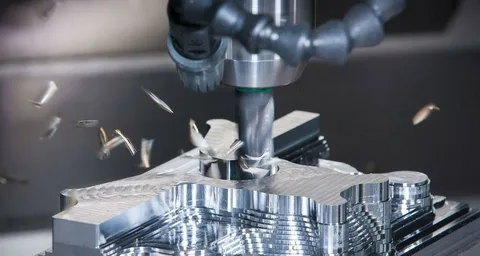In today’s world of manufacturing, the need for high-precision operations is more critical than ever. From aerospace to automotive industries, precision is non-negotiable, and even the smallest deviations can lead to catastrophic failures. One of the key players in achieving the required precision in modern manufacturing is CNC Cutting Tools. These tools are integral to the process of CNC (Computer Numerical Control) machining, which automates the control of machine tools like drills, lathes, and mills through computer programming.
CNC Cutting Tools are designed to provide accuracy, consistency, and efficiency in the production of parts that must meet strict specifications. The use of these tools is essential for operations that require high levels of detail and tight tolerances. This article will explore the importance of CNC Cutting Tools in high-precision operations, focusing on their advantages, types, and the role they play in driving efficiency and quality in manufacturing.
The Role of CNC Cutting Tools in Achieving Precision
CNC Cutting Tools are pivotal in ensuring high precision during the manufacturing process. Unlike traditional manual machining, CNC machines are controlled by computers, which use detailed codes and instructions to direct the tools with extreme accuracy. This enables the creation of components with tolerances as tight as a few microns, something human hands and manual machines could never replicate consistently.
The precision of CNC Cutting Tools comes from the advanced technology embedded within the machinery, allowing it to follow intricate designs and patterns without deviation. This level of control is particularly crucial in industries such as aerospace, medical device manufacturing, and automotive, where the smallest error could result in equipment failure or safety concerns. CNC tools enable manufacturers to produce parts with repeatable accuracy, reducing the risk of errors and waste while maintaining high production rates.
Types of CNC Cutting Tools and Their Applications
CNC Cutting Tools come in various types, each designed to perform specific tasks in the machining process. These tools include drills, mills, lathes, and turning tools, among others. Each type plays a vital role in shaping and finishing parts with high precision. For instance, end mills are ideal for creating complex shapes and contours, while drill bits are used for boring holes with exceptional accuracy.
Different applications require different cutting tools. In aerospace, for example, CNC Cutting Tools are used to create components with complex geometries, such as turbine blades or wing brackets, which need to fit together with the utmost precision. In medical manufacturing, CNC tools create intricate parts like surgical instruments or implantable devices. The versatility and adaptability of CNC Cutting Tools allow them to be used across various industries, all while maintaining the same high level of precision.
Benefits of CNC Cutting Tools in High-Precision Operations
The primary benefit of using CNC Cutting Tools in high-precision operations is their ability to maintain consistency and repeatability. These tools can produce thousands of identical parts without any variation in quality, which is a challenge for manual machining. This is particularly important in industries where standardization and quality control are critical.
Moreover, CNC Cutting Tools offer high material removal rates while minimizing waste. Their precision ensures that there is little to no need for secondary operations, such as reworking or adjusting parts. In turn, this leads to cost savings and improved efficiency. CNC machines also allow for more complex designs to be executed in less time, which accelerates production timelines and enhances overall manufacturing productivity. The combination of speed, precision, and cost-effectiveness makes CNC Cutting Tools indispensable for high-precision manufacturing.
How CNC Cutting Tools Contribute to Enhanced Productivity
In high-precision operations, time is a critical factor, and productivity is closely tied to how quickly and efficiently parts can be manufactured. CNC Cutting Tools contribute significantly to productivity by reducing setup times, minimizing the number of operator interventions, and enabling machines to run continuously with minimal supervision.
Additionally, CNC Cutting Tools are capable of multi-axis movements, meaning they can cut in several directions simultaneously. This not only speeds up the machining process but also allows for more complex and intricate shapes to be manufactured without the need for multiple setups. The result is faster production cycles and increased throughput, helping businesses meet high-demand production schedules while maintaining precision and quality.
Future Trends and Innovations in CNC Cutting Tools
The future of CNC Cutting Tools is marked by continuous innovation and technological advancements. One key area of development is the integration of artificial intelligence (AI) and machine learning with CNC systems. These technologies enable CNC machines to adapt to changing conditions during machining, making real-time adjustments to optimize cutting processes and improve precision further.
Additionally, advances in materials science are leading to the creation of cutting tools with enhanced durability and wear resistance. New coatings and composite materials are being developed to increase the lifespan of CNC Cutting Tools, reducing the frequency of tool changes and downtime. As the demand for higher precision and more complex parts grows, CNC Cutting Tools will continue to evolve, providing manufacturers with the tools they need to meet the challenges of modern production.
Conclusion
In high-precision operations, the use of CNC Cutting Tools is indispensable. These tools provide manufacturers with the ability to produce parts that meet strict specifications with incredible accuracy, consistency, and speed. Whether it’s through reducing production costs, improving quality, or enhancing productivity, CNC Cutting Tools play a critical role in modern manufacturing. As technology continues to advance, the role of these tools will only become more significant, ensuring that manufacturers can meet the ever-increasing demand for high-precision components across industries.
